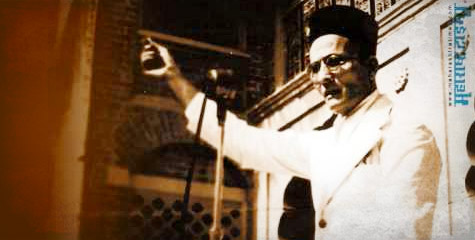
In my last post, I had explored Savarkar’s arrest, epic escape at Marseilles . I now look at the most important phase in his life, the trial in India and his detention at Cellular Jail.This is because I feel, this was the most significant phase of his life. It shaped his outlook, his character, his ideology. More important, many have this very wrong feeling, that Savarkar begged the British for amnesty. If only they knew what this man underwent in Cellular Jail. And his plea for amnesty, was more a tactical retreat, something that every one does. To use that incident, as an excuse to paint him as a British agent, is doing the greatest disservice ever to one of the greatest nationalists ever.

Savarkar, was sent to Andamans on June 27,1911. As he reached the place, his thoughts were more on how these islands, could be the outposts of a Free India. In a way it was prophetic too, when Netaji began his long armed struggle, he first captured Andaman and Nicobar Islands, which he promptly renamed as Shahid and Swaraj. Cellular Jail was a literal hell on earth, the kind of place, you would not even wish for your worst enemies. It became a place, where the British Government sent, those freedom fighters, whom they regarded as particularly dangerous. And Savarkar to them was a far more bigger danger, than any of the petition pushing Congress leaders. The prisoners were put to the worst form of torture, to break their spirits. The most vicious Pathans were employed to beat the prisoners, and they had absolutely no qualms whatsoever.
The jailor Barrie, hated the revolutionaries, and inflicted the worst possible tortures on them. They were yoked like cattle to the oil mill, and made to work all day. Back breaking labor, that could literally sap the life out of any one. And it did to many a prisoner, in this death land, where they entered, but rarely returned back. The horrors of Cellular Jail, were on par with those of Auschwitz, Devil’s Island and the Gulags of Russia. Imagine living a life of solitary confinement, for not just one or two years. But for 12 years, yes, that was the amount of time, Savarkar spent in solitary confinement. Given the task of chopping coconuts with a heavy mallet, Savarkar’s hands bled. He was yoked to the oil mill, and made to work hard. And yet all the indignities inflicted upon him, Savarkar, bore it with fortitude, patience and character.

Savarkar not just bore the indignities inflicted on him, he also lifted up the spirits of his fellow prisoners. For most of them living a life, sapped out of energy, Savarkar’s very presence, lifted their spirits. Savarkar felt that Ujjain being in the center of India, was the right capital for it, not Delhi at all. Around the same time, an assassination attempt was made on Lord Hardinge. The man responsible for it Rash Behari Bose, fled to Japan, where he would later found the INA. In the meantime, Savarkar began to educate the prisoners on political science, economics and Constitutional law. He fought with the authorities to secure the rights of prisoners, and give them the basic amenities. He impressed upon the prisoners, the need for education especially on economics and constitutional law. In future, when India would be free, that knowledge would be need a lot for governance.
“Knowledge without action was lame and action without knowledge was limited”
Yogavasistha and the Imitation of Christ by Thomas Kempts, were two books that were Savarkar’s personal favorites. However Savarkar felt it was time, people in India get to know of the horrors of Cellular Jail. One Hotilal Verma, secretly managed to send a letter to Surendranath Banerjee, one of Savarkar’s staunch admirers, on the horros of the Cellular Jail. Indu Bhushan Roy, Ulaskar Dutt arrested for the Alipore bomb case, Nani Gopala, were some of those who had suffered the most. As the news of the horrors of Cellular Jail, spread in the Indian press, there was massive outrage all over. The Imperial Council questioned the British Government, public opinion began to grow against the atrocities, and finally they sent their home secretary Craddock in 1913. In the meantime Savarkar along with Nani Gopala, went on a hunger strike, before it ended with assurancs from the authorities. Finally faced with a hostile public opinion, stinging criticism in the press, the British government relented and decided to release those prisoners whose conduct they deemed satisfactory.
In the meantime Savarkar, made use of his solitary confinement to write. However with no reading and writing material, he used the prison as his medium. The walls of the prison turned into pages, the stones and thorns became the pens, and he wrote no less than 10,000 lines of poetry. An epic ballad on Panipat, composed entirely on the walls of his prison, one of the greatest literary feats ever. He was one of the greatest writers ever, often rated equivalent to Kalidasa, by the Marathi critic Madkholkar. His magnum opus Kamala is often regarded as the Shakuntala of modern India, in it’s usage of similes, and it’s graceful composition. He also introduced a blank metre verse called Vinayak in Marathi poetry.

His long time in Andaman, and the solitary confinement, began to bring a philosophical outlook towards life. Having experienced the worst ever indignities and torture, for him death really held no fear. And this was the time, when he began to formulate the philosophy of Hindutva. How exactly this philosophy took shape, and it’s ideals, we shall be seeing in the subsequent posts.
Source-Veer Savarkar by Sanjeev Nayyar.

Pingback: Veer Savarkar-Who is a Hindu? | History Under Your Feet
Pingback: Veer Savarkar | History Under Your Feet
Pingback: Veer Savarkar - Who is a Hindu? -
Pingback: Savarkar My Hero | History Under Your Feet